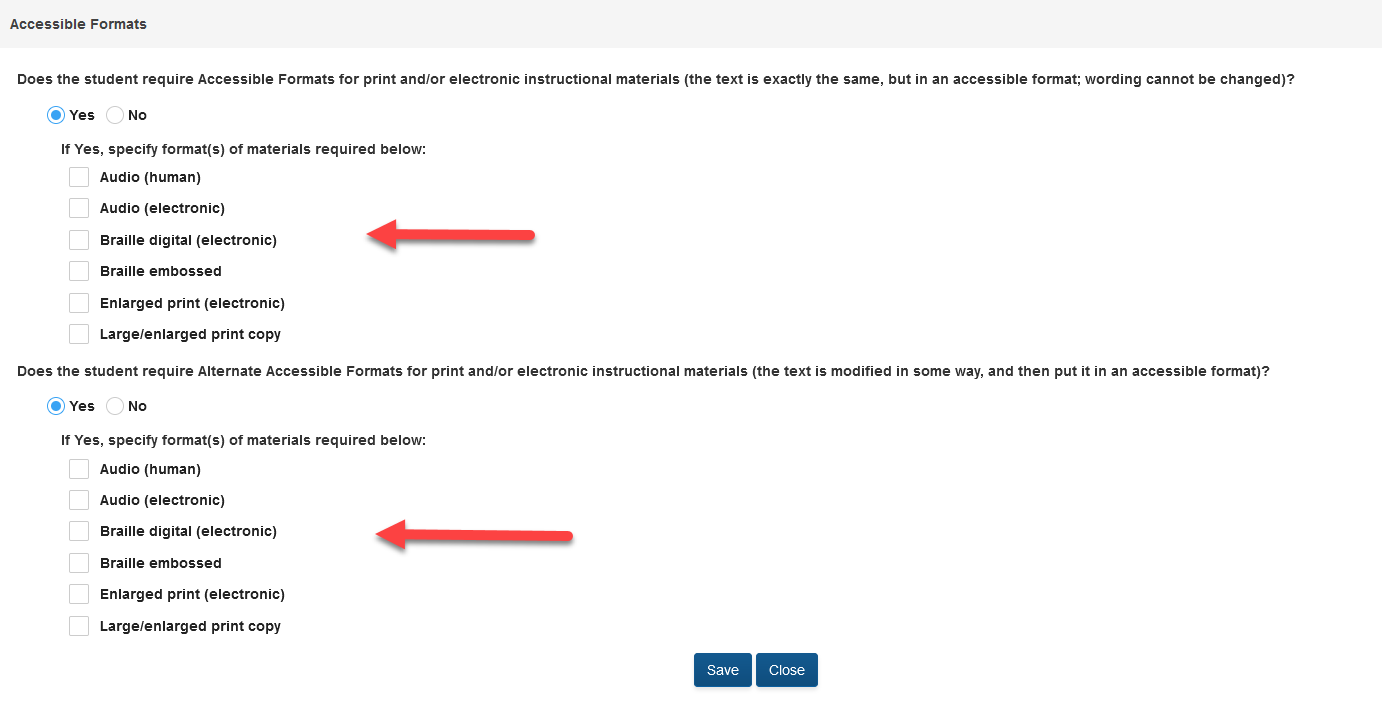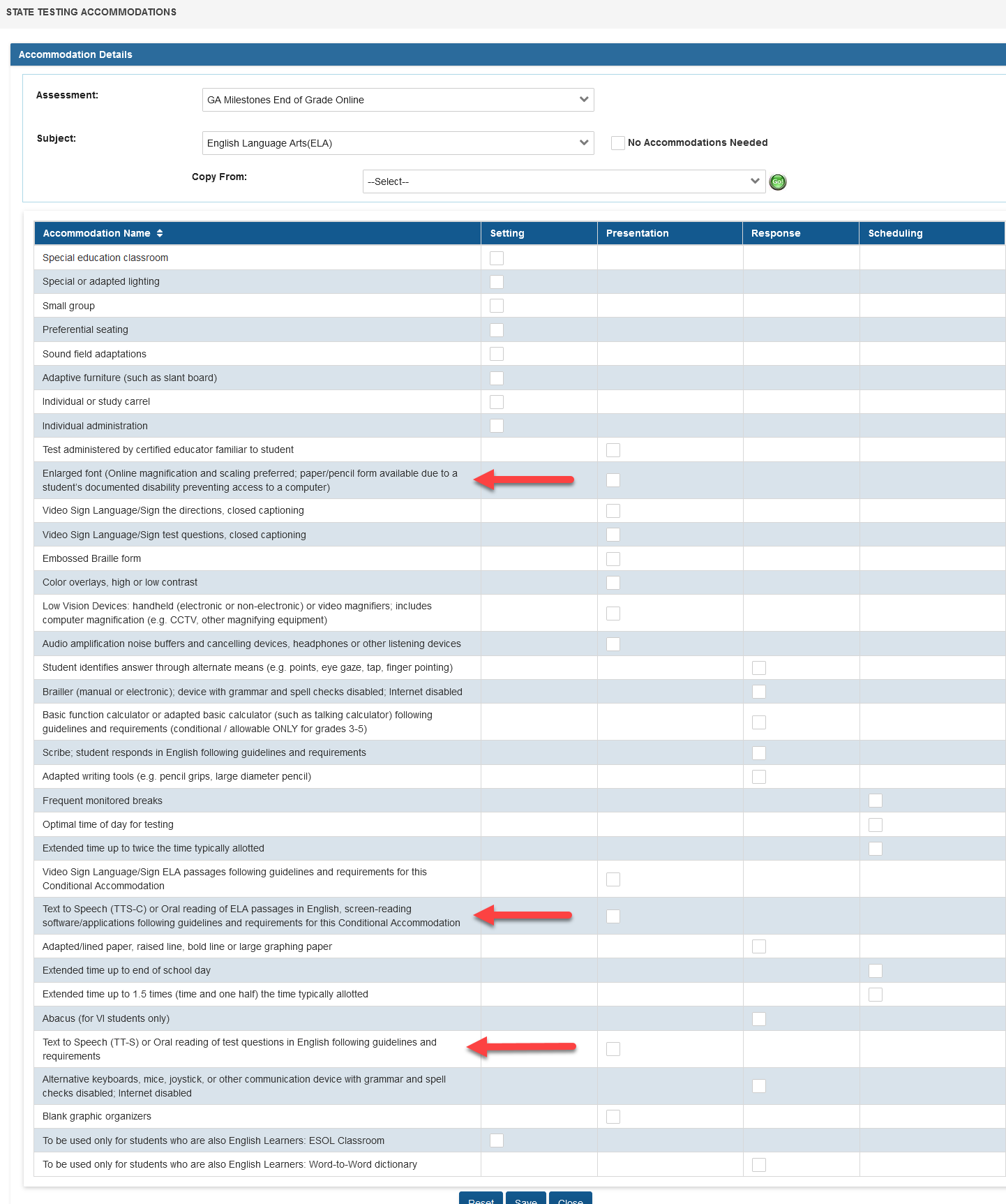Accessible Formats (required)
Accessible educational materials (AEM) are available in a variety of formats providing print and technology-based educational materials in a format appropriate for the individual student.
Accessible materials use the exact text as copyrighted text, and the wording cannot be changed. Copyrighted text is not required to be at student's grade level.
Alternate Accessible Formats (AAF)
- Students instructed using grade-level content standards may need the copyrighted text to be modified to access grade-level standards and also need the material in an accessible format.
Students instructed using alternate content standards always need modified content and may also need the material in an accessible format.

If "yes" is selected, specify the format(s) of materials required from the list.

Audio (human): Text read aloud to a student by a teacher, paraprofessional, or other adult.
Audio (electronic/text-to-speech): Text produced in electronic file formats that require assistive technology. Files can be accessed auditorily with text (text to speech) or without text (audio file). Files may also be used in conjunction with several technologies to meet individual student needs such as but not limited to refreshable braille displays and enlarged print on mobile devices. Information regarding data-based selection of reading accommodations is available at www.gimc.org (see the Administrator Section of the Educators page).
Braille digital (electronic): Electronic braille files, e.g., *.brf, *.b2k, *.dbt file extensions, that can be utilized by refreshable braille display assistive technology devices.
Braille embossed: Text converted to braille and embossed on braille paper.
Enlarged print (electronic): Digital text files, e.g., *.html, *.pdf, *.docx that can be increased in size using the application(s) that electronically display these file types. This does not include electronic or non-electronic magnification assistive technology devices.
Large/enlarged print copy: Hard or soft copy books printed with larger fonts compared to the original text (ISBN). Large print books are the same dimensions (length X width) as the original published copy (ISBN), while enlarged textbooks have larger overall dimensions compared to the original text (ISBN).
If a student requires the accommodation of oral reading of test questions or oral reading of reading passages in the State Required Testing/Student Supports section of the IEP, then this accommodation should also be considered in the Consideration of Special Factors section of the IEP under Accessible Formats for Audio (human) and/or Audio (electronic/text-to-speech). If a student requires the accommodation of Enlarged font in the State Required Testing/Student Supports section of the IEP, then this accommodation should also be considered in the Consideration of Special Factors section of the IEP under Accessible Formats for Enlarged print (electronic) and/or Large/enlarged print copy.
Audits in GO-IEP will require that both areas are addressed.

The following questions may guide you in making these decisions:
- Accessible Formats needed: Is Assistive Technology necessary to support use?
- Assistive Technology needed: Are Accessible Formats being accessed in digital format?
- Alternative (modified) Accessible Formats needed: ill Assistive Technology and/or Accessible Formats be necessary?
- Testing accommodations requiring Assistive Technology or Accessible Formats: Are they documented in the Special Factors for daily access to the curriculum?
IEP considerations chart to assist your decisions.
|
Print-based Instructional Materials |
||
|
|
Require an Accessible Format Production |
Require AT |
|
|
|
|
Yes |
Yes |
|
Yes |
No |
|
|
|
|
No |
Yes |
|
Yes |
No |
|
Yes |
Yes |
|
|
|
|
Yes |
Yes |
|
Yes |
No |
|
Electronic-based Instructional Materials |
||
|
|
Accessible Format Production |
AT Required |
|
|
|
|
No |
Yes |
|
No |
No |
|
|
|
|
N/A |
N/A |
|
No |
No |
|
No |
Yes |
|
|
|
|
No |
Yes |
|
N/A |
N/A |